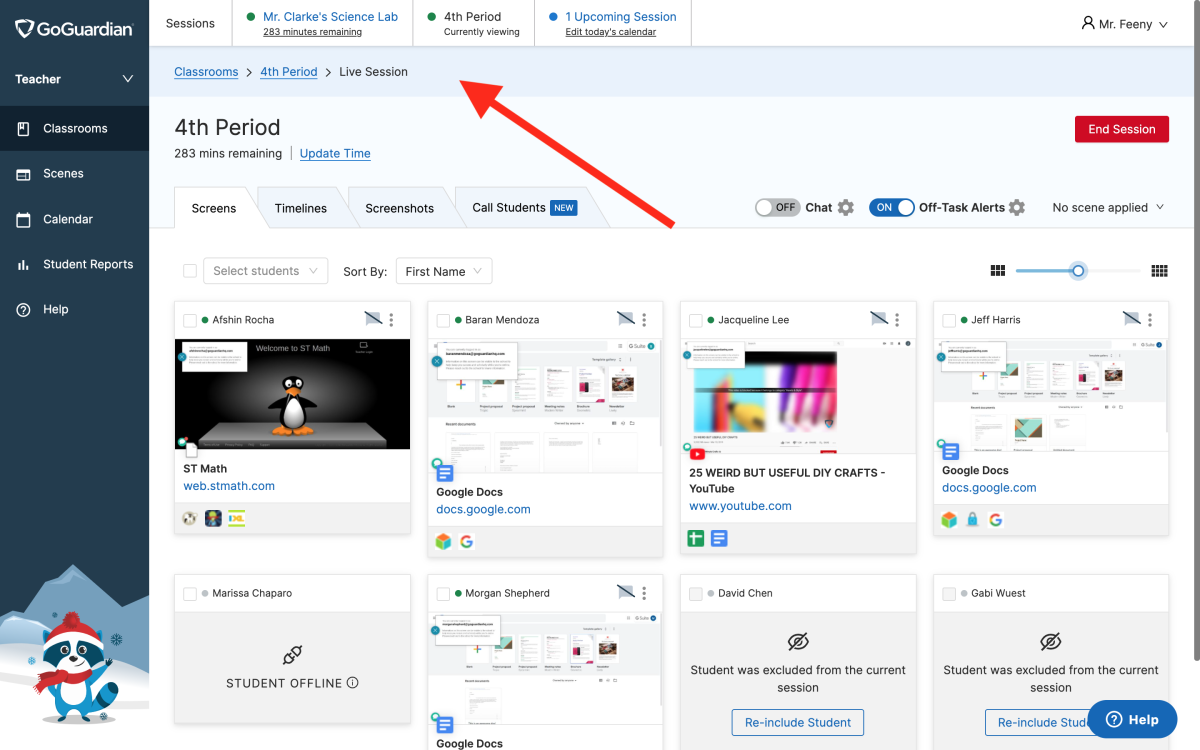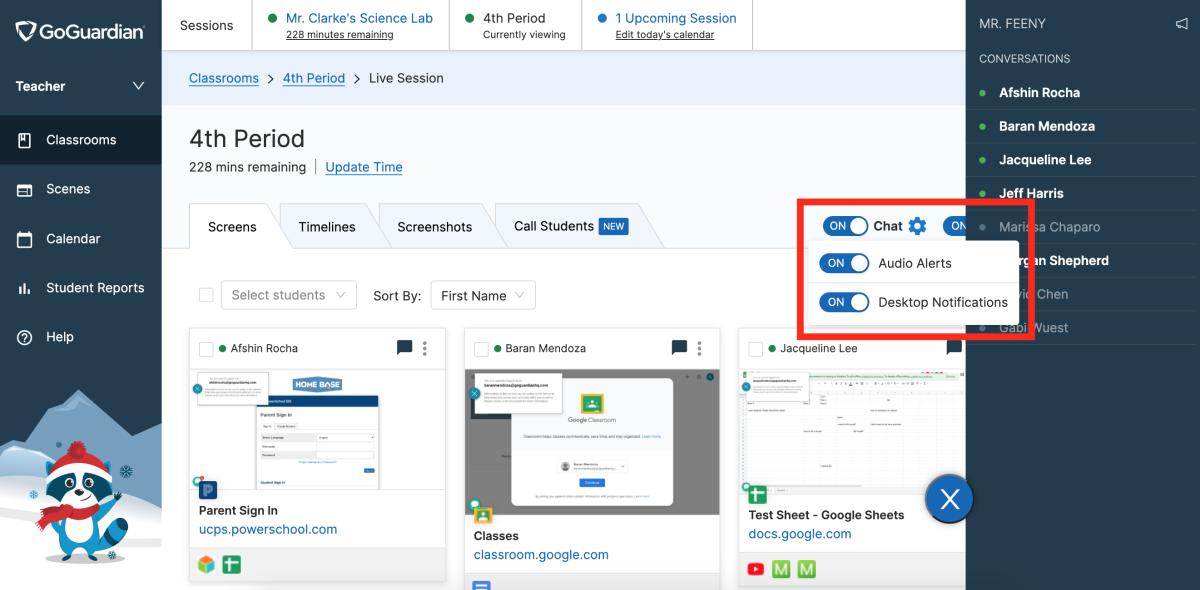Using GoGuardian Teacher for Asynchronous Remote Learning

Your students trickle into the classroom and find their seats. You log in to GoGuardian Teacher™, click on the current classroom, and start your session (or maybe you schedule your sessions? Stay tuned for some updates there!). We all know this workflow, and we’ve learned how to use GoGuardian Teacher in a classroom setting. But now that classrooms have gone remote and you may not be covering lessons synchronously with the whole class, how should you use GoGuardian Teacher?
Asynchronous Learning is a term used to describe forms of education, instruction, and Learning that do not occur in the same place or at the same time. This often means posting assignments in the morning or at the beginning of the week, and then letting students work on their own.
In this article, we’ll cover some tips on how best to use GoGuardian Teacher for asynchronous Learning. But first, let’s discuss shifting our perception of this tool.
Using GGT to help guide students, rather than to monitor and correct off-task behavior.
Many teachers use GoGuardian Teacher to make sure students are staying focused and on-task in the classroom. As a teacher, you can see student screens and the different tabs they have open. If they go off-task, you can correct that behavior by locking their screen or closing a tab. But now that students are Learning remotely, you may not always know when they are working on a particular class’s material. Your class may normally start at 11 a.m., but what if the student has made this their lunch hour or perhaps has chosen to work on a different class’s assignments during this time?
When students aren’t working on assignments for your class, it’s not necessary to monitor their work. So rather than using GoGuardian Teacher as a monitoring tool, consider using it as a way to deliver instruction and guide students once they’ve asked for help or have identified that they are working on your class material. If a student tells you that they are having trouble with an assignment for your class, then you can click on the student tile, see how they are interacting with the material, and offer guidance!
Tips for Using GoGuardian Teacher for Asynchronous Learning:
- Run your class sessions all day.
- Turn on Chat to be available for students.
- Deliver simple instruction via Announcements.
- Don’t use Scenes!
- Don’t use Individual Student Reporting as a punitive tool, but rather use it for attendance and participation.
- Hold office hours.
1. Run your class sessions all day
Because students may work on your class material at different times of the day, we recommend starting your sessions in the morning and having them run all day. You can run multiple classroom sessions at the same time and navigate between them at the top of your GoGuardian Teacher interface. As we mentioned at the beginning of this article, you are not running sessions in order to monitor and correct students’ off-task behavior. You are running the sessions all day so that you can be available to students whenever they choose to work on your class material.

2. Turn on Chat
We’ve mentioned that you’re running sessions all day so that you’re available to students when they need help. But how will you know when they need help? We recommend turning on Chat for each of the class sessions you’re running. This way, whenever a student is working on your class material and needs help, they can reach out to you through GoGuardian Teacher’s Chat feature. This feature includes audio notifications, desktop notifications, badges to show the number of unread messages, and more!
One thing to note is that audio notifications will only occur for the active session you have open. If you are running four sessions simultaneously, you will only hear audio notifications for messages in your open sessions. This is also the case for desktop notifications—you will only receive desktop notifications for messages that occur in the session you have open. You can click on each of your different active sessions to make sure that you are seeing all chat notifications. But one workaround is to open each active session in a new tab. If each of your active sessions is open in its own individual tab, you will receive audio notifications and desktop notifications for all active sessions.
Another thing to note is that you have the ability to turn on Chat for individual students. You don’t have to turn on Chat for the entire class if you only want to be available for one or a few students. However, just be mindful that some students will not be able to reach out to you for help if you have not turned on Chat for those students.

3. Deliver simple instruction via the Announcement feature
So you’ve started all of your classroom sessions. Now you want to communicate today’s assignment, deliver simple instruction while students work asynchronously, or just let students know that you’re available to help. Using the Announcement feature, you can send a message to the entire class. Even students that are offline will see your announcement, once they have logged in and are online. This way, all of your students, even the ones who are offline because they are taking a break or haven’t started working yet, will still get your message.


You can use Lecture/Presentation or Video Call/Presentation feature in our Video Conferencing tool to deliver a full lesson in a synchronous teaching format. This will enable you to start a virtual classroom session with any or all students in the current GoGuardian Teacher session.
4. Avoid using Scenes
Using Scenes is a great way to make sure that students are staying on productive websites so you can get away from monitoring on your computer and interact with students face-to-face. However, Scenes can be a little tricky in an asynchronous Learning environment. For example, if you apply a Scene that restricts students to only accessing 10 websites, but a student starts working on assignments for a different class, they may need to access websites beyond the 10 that you allowed. Even if you apply a less restrictive Scene, such as one that only blocks Netflix and YouTube, students still may need access to YouTube for another class or want to watch Netflix on their lunch break.
Because you never know when a student plans to work on your class assignments, we recommend not using Scenes during asynchronous Learning, as not to cause problems for students or other teachers. However, if your school has set up a system specifically to use Scenes, perhaps for testing, and has created a plan around Scenes usage, please follow their instructions. We have seen models in which students notify the teacher that they are ready to take a quiz or test, and then a teacher sets up a classroom with the students who are taking the exam and applies a scene only to those students. But because we recommend using GoGuardian Teacher as a way to be available to students during distance Learning, rather than use it as a way to monitor and restrict students, we generally discourage using Scenes during asynchronous Learning. If you have further questions around using Scenes during asynchronous Learning, we recommend speaking with your IT administrator.
5. Change the way you use Individual Student Reporting
Normally we would use Individual Student Reporting after class to check whether students were staying on-task and browsing educational content related to your class. However, now that your sessions are running all day, the individual student reports will show all student browsing while your session was running. The report may include periods of time when the student was working on your class assignments, but it can also include times when the student was working on other class assignments or taking a break from schoolwork altogether. Because of this, we do not recommend using Individual Student Reporting in a punitive way. That is to say, we do not recommend penalizing a student when you see that off-task behavior in these reports.
However, some teachers have been using reports to see whether a student has logged in at all. Some teachers have students that have gone MIA, and they’ve had difficulty getting into contact with these students to see whether they are continuing their education while remote. Seeing that a student has logged in can help teachers know whether the student has really fallen off the grid, or whether they are logging in and able to be contacted. Some teachers are also just checking student reports as a way to take attendance.
6. Holding office hours?
With asynchronous remote Learning, teachers often give out assignments and then hold office hours so that students who need help can get some guidance. While we recommend having Chat enabled all day, GoGuardian Teacher also has a screen-sharing feature that enables teachers to share their screen with students, share their video, and/or share their audio. So if you deliver instruction via Announcements in the morning and indicate that you will hold office hours at a particular time, students can send a message indicating that they want to come to your office hours. With the screen-sharing functionality, you can choose to share your screen, audio, and/or video, select the students to whom you want to present, and then walk through the content and assignments one-on-one or in small groups.
Read this article for the most recent updates to the Video Conferencing feature in GoGuardian Teacher.
Visit our Distance Learning Center for more resources to support your digital classroom.
Jump to Section
Bring the power of GoGuardian to your school or district today.


